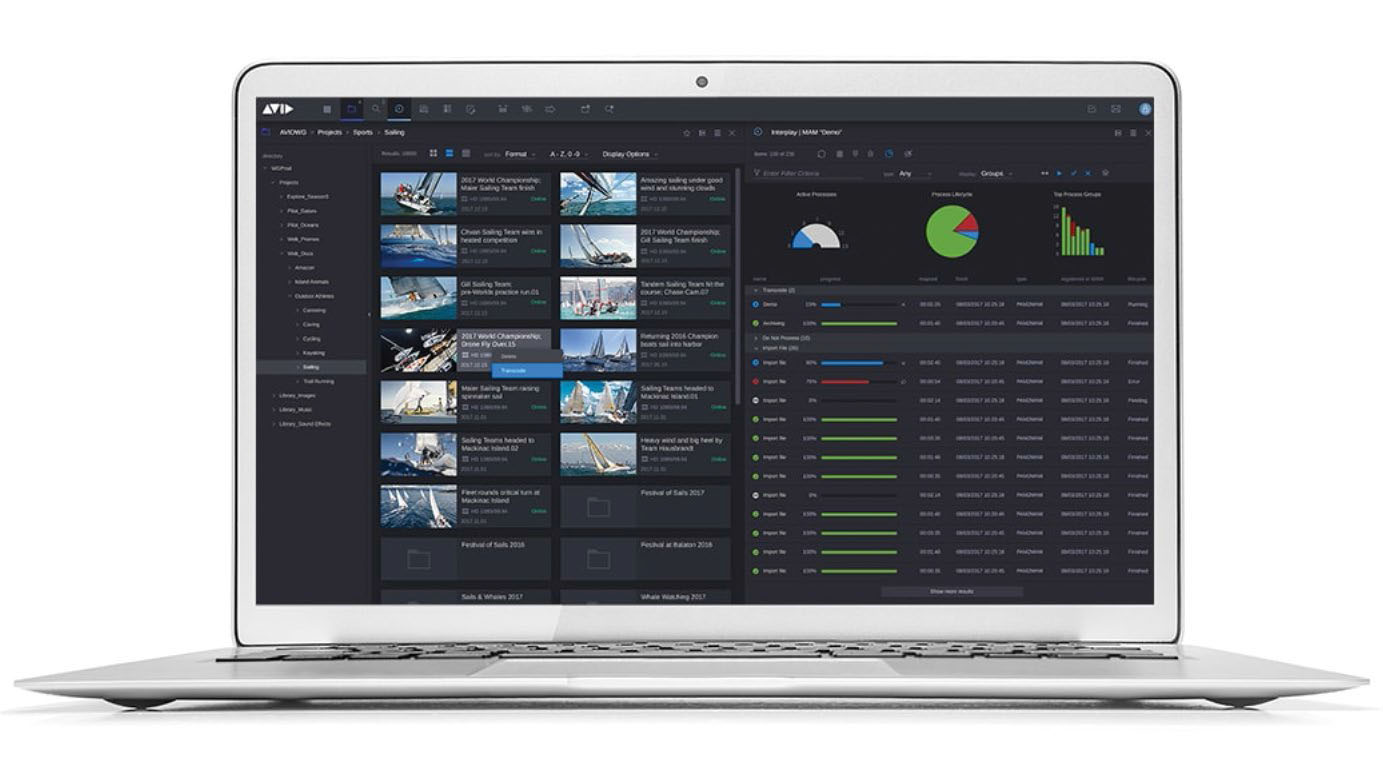Feeding an Increasing Number of Screens
ALEXANDRIA, Va.—Despite differences in features and distinctions in functionality, the technology at the center of digital content management is aiming for one clear, single goal: To give media companies the ability to thrive amongst the myriad disruptions our industry is experiencing.
Today, the second screen has morphed into the first screen. And now that consumers are calling the shots when it comes to watching whenever and wherever they choose, technology central to content creation and management has to lead the way.
It’s a challenge for us all, but also an opportunity, said Ray Thompson, director of broadcast and media solutions marketing at Avid.
CREATING OPPORTUNITIES
A key opportunity is to find a better way to monetize the connections that are happening on those small screens, especially on social media. According to a recent Pew Research Center report, about two-thirds of Americans today get news from social media outlets. A majority of those Americans cite convenience as a key reason why they consume news from social media sites. Another key reason behind social media’s popularity: speed of delivery.
That’s what led companies like Avid to introduce solutions like MediaCentral | Publisher, a new SaaS offering designed to increase viewership and engagement across social media and digital OTT platforms for news and sports.

“With [this solution] Avid has significantly improved our customers’ ability to be first to deliver news on digital platforms,” Thompson said. The company has partnered with Wildmoka, a French software company, on this particular MediaCentral solution.
In today’s day and age, being first matters. Being first to deliver content to readers not only improves their ability to engage viewers, but it also drives consumers to their digital platforms and increases digital revenue, Thompson said.
This SaaS offering provides auto transcoding, which means media companies do not have to set up separate rendering farms for transcoding. “Once the content is in the cloud, they can do things like resize the aspect ratio of content, add graphics for different mobile platforms and customize branding,” Thompson said. MediaCentral users can log content, search for and access media, create a highlight sequence in the timeline, and then publish across social and digital platforms.
Another clear goal for media companies: engagement.
The Pew Research report found that 43 percent of those consumers surveyed use social media sites as a pathway to news, with Facebook, YouTube and Twitter leading the way. From there, consumers are often linked directly to a content creators’ news site and conversely connected to pre-, mid- and post-news ads as a way to more meaningfully direct advertising to viewers.
“Customers [are] learning that they need to be first and they need to really go viral,” Thompson said. “They become a source for breaking that news. They can do that and can drive views and drive traffic to their own ads.”
Helping media companies address that new business reality is a key goal. At the recent 2019 IBC show in Amsterdam, a number of technology firms showcased improved content creation toolsets designed to help customers deal with increasingly complex issues such as workflow and business opportunities.
Primestream, for one, highlighted its new Creative Extensions solution, which connects video, graphics and visual FX teams with tools to locate, manage and import assets and projects from within the NLE, making it so that users never need to leave their Adobe Photoshop, After Effects or Apple Final Cut Pro X systems when creating and managing content.
Others like Vizrt are introducing software-defined visual storytelling platforms designed to revolutionize how virtual studio sets and augmented reality graphics are designed and combined with live video. At IBC, Vizrt introduced Viz Engine 4, a graphics engine and video compositing platform for live video productions. The system handles graphics creation, virtual environment development, augmented reality control system and template-driven workflows for storytelling flexibility.

“For us at Vizrt, the key qualities that our customers are looking for [when it comes to content creation and distribution] are led by a director-based user interface that removes layers of complexity and gives the optimum ability for quick reactions, better storytelling and [the ability] to execute a complex error-free production,” said Víctor Josué Quintana Ramos, technical sales specialist for Vizrt.
ARTIFICIAL INTELLIGENCE
As the industry looks past storytelling and toward the challenges of improving content management workflow, the promise of AI appears again and again.
“Artificial intelligence provides the opportunity to systematically learn about the content the data represents and use that knowledge to make better, more efficient decisions about the workflow,” said Namdev Lisman, executive vice president of Primestream.
The newest version of the company’s Elastic Data Viewer, which was shown at IBC, is a solution that integrates with AI platforms in an effort to enrich content with facial and object recognition, speech-to-text transcription and sentiment analysis, he said.
“For decades, media content has been a hand-crafted product, relying heavily on skilled artists and craftspeople to use their time and talents for every step—even the trivial, mundane and repetitive steps,” he said. AI is now offering similar productivity opportunities. While media management has previously been about collecting, tracking and utilizing information about data files, any information about the content in those files relied on some level of human interaction—including the time and potential for error that comes along with it, Lisman said.
Primestream is using AI to provide media companies a means of using AI metadata as a driver of workflow activity, Lisman said.
“And the more we know about the content, the more efficient we can make the workflow,” he said. “This is the greatest benefit of AI in media production: using compute power to discover useful, interesting or necessary moments in content, and freeing up humans to make better decisions about what happens next.”
One successful project scenario occurred when AI was used in the video production department for the Organization of American States (OAS). AI technology was used to recognize every representative speaker within any video generated from any OAS session. Audio content would be concurrently transcribed from multiple languages and then redelivered to 35 OAS member countries, which includes every country in the Americas.
“This is a significant improvement over the previous manual process, which could take up to 30 days to accomplish the same tasks,” Lisman said.
Integrating AI is also a priority for Vizrt, which moved to keep its Viz Engine 4 an open, collaborative system. “What this brings to the table to the vast community of developers and designers are … the possibilities of using physics and using AI in the gaming engine,” said Gerhard Lang, CTO of Vizrt.
A number of other technology companies are also redoubling their efforts to focus on review and quality control technologies. That was the thinking behind Telestream’s new tools for live streaming of events and sports and how media companies can monitor quality at each point in the distribution pipeline.
The company showcased the newest version of its OptiQ Monitor at IBC, a quality of service and experience measuring system that can be inserted virtually in the media distribution pipeline for live streaming. The OptiQ framework includes the OptiQ Channel, an integrated monitoring system. Conversely, the new OptiQ Monitor works within any public cloud data center, allowing a customer to specify the type of monitoring probes needed in that data center. According to Primestream, the system begins QoS and QoE monitoring of a customer’s live streaming channels and gives that user the ability to observe how their CDNs are performing across multiple geographies.
Most importantly, the system allows a company to pinpoint degraded performance and take steps to improve it before a viewer gets distracted and stops watching.
“[The system] provides real-time identification of critical delivery faults like CDN cache performance issues, missing ABR variants, content availability problems, live content quality measurement and compliance,” said Ken Haren, director of product management at Telestream.
“This delivers live visibility into what may be impacting audience engagement concurrently across many regions—pinpointing degraded performance and remediation steps before viewers tune out,” he said.
That same goal was in place for Primestream with the release of ReviewHUB, a solution that shares and collects feedback on media across an organization and with external collaborators. The system uses privacy controls like watermarking, password protection and time specific expiration, and integrates those within the ReviewHUB platform.
As content creator continue to search for the best pathways to thrive in today’s fractured media market, technology is providing answers in the form of AI integrations, QoS monitoring, SaaS offerings and software-defined virtual storytelling. Yes, consumers are now calling the shots when it comes to when and where to watch. But today’s content creation and management technology is helping to lead the way.
Get the TV Tech Newsletter
The professional video industry's #1 source for news, trends and product and tech information. Sign up below.
Susan Ashworth is the former editor of TV Technology. In addition to her work covering the broadcast television industry, she has served as editor of two housing finance magazines and written about topics as varied as education, radio, chess, music and sports. Outside of her life as a writer, she recently served as president of a local nonprofit organization supporting girls in baseball.

